Midnight Commander (MC) is a free and open-source file manager that provides a text-based user interface. It is available on numerous Unix-like systems, including Linux and macOS. It uses a two-panel layout, allowing users to view the contents of two directories simultaneously. This design makes it easy to move or copy files between directories. Due to its text-based user interface, MC functions exceptionally well on remote servers where graphical environments are unavailable, making it an indispensable tool for system administrators and developers.
How to change midnight commander colors
One of the main adjustments developers make while working with Midnight Commander is altering its interface colors. In this article, you’ll learn how you can tailor the colors to your own requirements 🙂
Choosing a color scheme from built-in options:
MC usually offers several skins from which you can select the one that suits you best. To do this:
Launch Midnight Commander. Start by opening the terminal and typing:mc
Once MC is running:
Press F9 to access the main menu.
Select Options.
Then choose Appearance.
You will see a list of available color schemes. You can test each one by selecting it and pressing Enter.
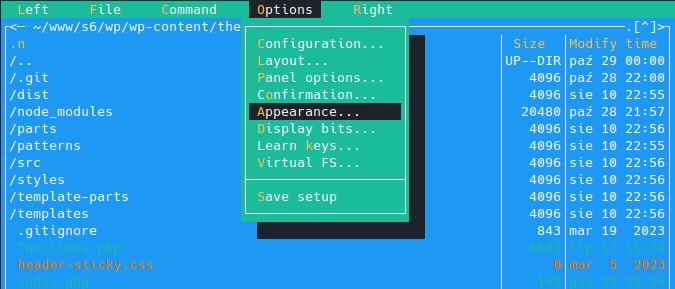
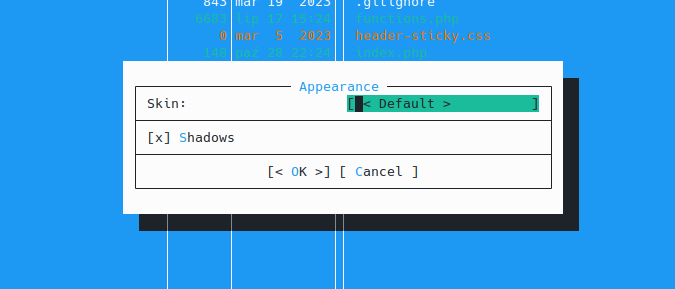
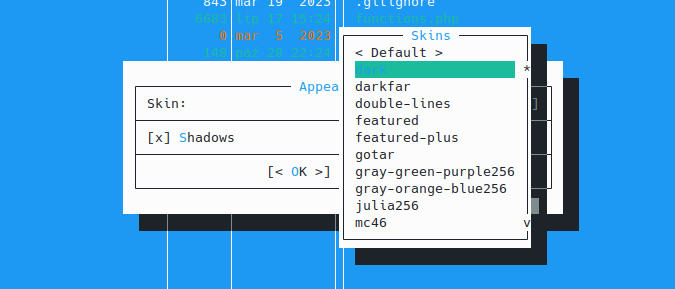
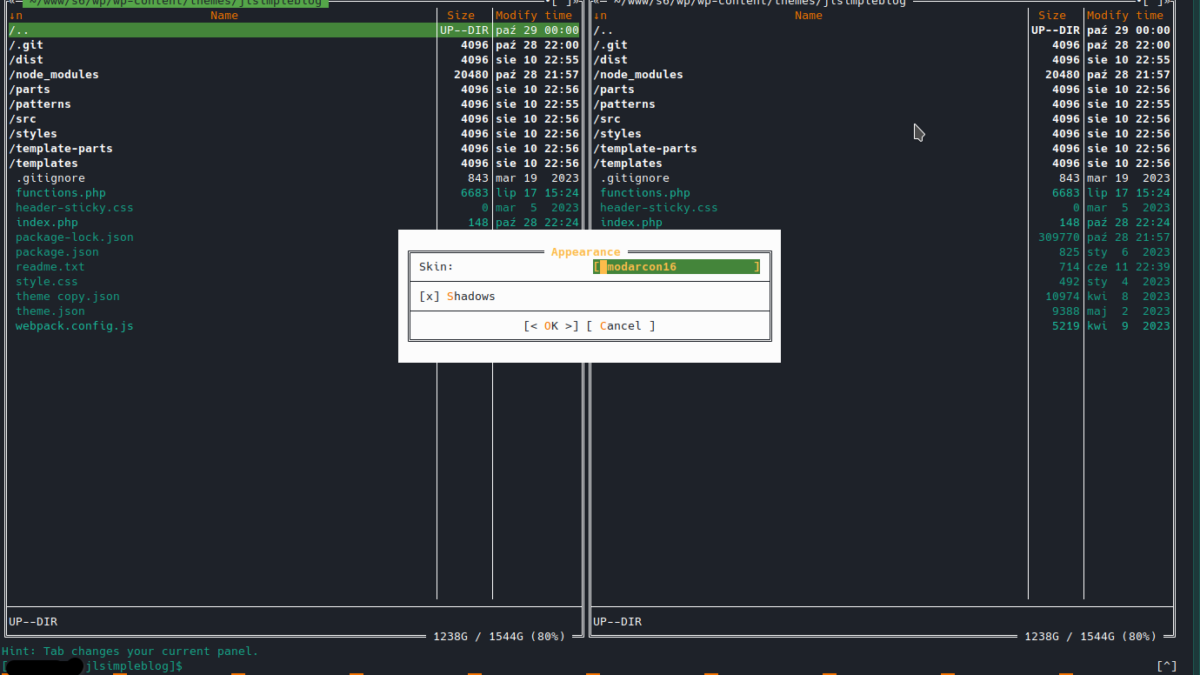
Creating your own color scheme:
If you wish to craft your color scheme, open the file ~/.config/mc/ini in your preferred text editor, e.g., nano:nano ~/.config/mc/ini
Locate the [Colors] section (or create it if it doesn’t exist) and define your color scheme. For instance:
base_color=normal=white,black:selected=gray,white:marked=yellow,blue:markselect=blue,yellowThese settings represent:
normal – text and background color (white text on a black background)
selected – color of highlighted text and background (gray text on white background)
marked – text and background color of a marked item (to mark an item use the Insert key) (yellow text on blue background)
markselect – text and background color of a highlighted marked item (blue text on yellow background)
You can use colors: black, gray, red, brightred, green, brightgreen, brown, yellow, blue, brightblue, magenta, brightmagenta, cyan, brightcyan, lightgray, and white.
For more information about colors, type the following command in the console:mc --help-color
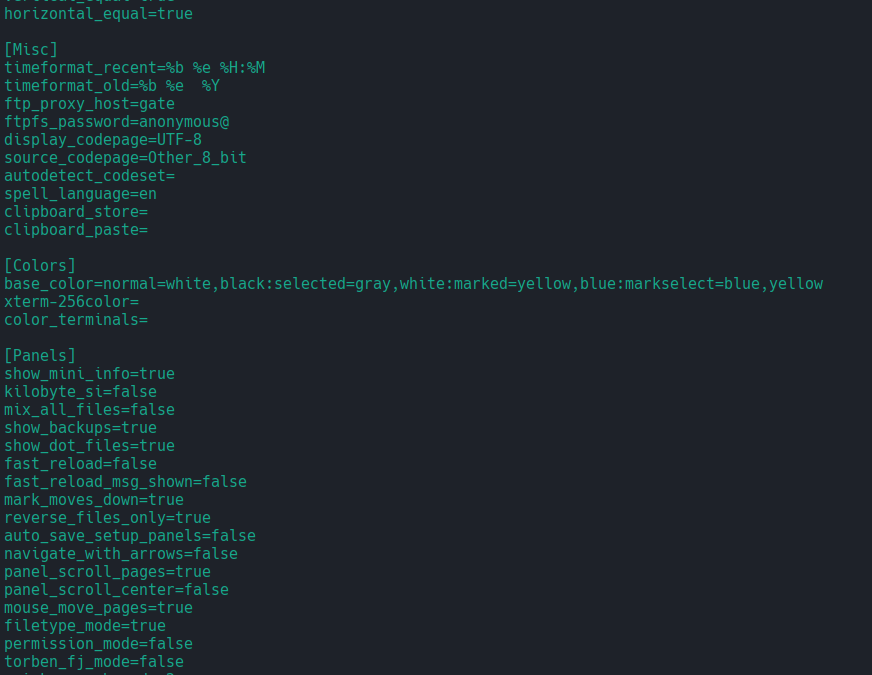
After configuring your preferred colors, save the changes in the file (for nano, save as CTRL+O, to exit press CTRL+X).
Restart mc.
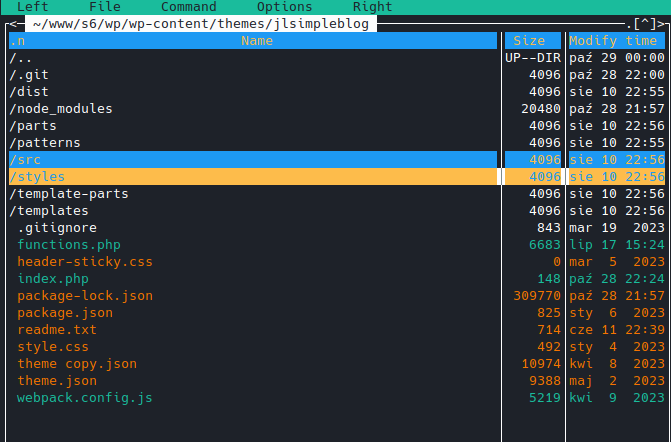
Crafting your color set in the form of a ‘skin’:
If you desire more flexibility in altering MC’s colors, you can create your custom skin.
For this, navigate to the directory ~/.local/share/mc/skins (or create it if it doesn’t exist) and generate your file, e.g., my_skin.ini.
Ensure the file has the appropriate write permissions:chmod 644 ~/.local/share/mc/skins/my_skin.ini
Inside the my_skin.ini file, add color settings for various interface elements:
- core,
- menu,
- dialog,
- popupmenu,
- error,
- filehighlight,
- buttonbar,
- statusbar,
- help,
- editor,
- viewer,
- diffviewer.
Again, you can rely on the Midnight Commander color hints:mc --help-color
This will display keywords you can utilize while setting your colors:
Keywords:
Global: errors, disabled, reverse, gauge, header
input, inputmark, inputunchanged, commandlinemark
bbarhotkey, bbarbutton, statusbar
File display: normal, selected, marked, markselect
Dialog boxes: dnormal, dfocus, dhotnormal, dhotfocus, errdhotnormal,
errdhotfocus
Menus: menunormal, menuhot, menusel, menuhotsel, menuinactive
Popup menus: pmenunormal, pmenusel, pmenutitle
Editor: editnormal, editbold, editmarked, editwhitespace,
editlinestate, editbg, editframe, editframeactive
editframedrag
Viewer: viewnormal, viewbold, viewunderline, viewselected
Help: helpnormal, helpitalic, helpbold, helplink, helpslink
For convenience, I’ve included the color settings file of my skin (primarily in black, white, and blue hues) along with the descriptions of each option:
#
# JL skin
#
[skin]
description = JL Skin
256colors = false
[core]
_default_ = white;default // text color (foreground/background)
selected = white;blue // selected item color (foreground/background)
marked = white;brightblue // marked item color (foreground/background) - Insert key
markselect = black;blue;;bold // marked and selected item (foreground/background)
gauge = white;blue // progress bar colors
input = white;black // color of the text input areas
inputmark = white;brightblue;bold // color of marked (or selected) text within an input area
inputunchanged = blue;white // color of an input area that hasn't changed or been modified
commandlinemark = white;brightblue;bold // color of marked text within the command line specifically
reverse = white;brightblue // color swap, where the foreground and background colors are switched
header = white;black // header color (foreground/background)
disabled = gray;lightgray
errors = white;red // errors colors (foreground/background)
[menu]
_default_ = white;default // menu colors (foreground/background)
menusel = white;blue;bold // focus menu element (foreground/background)
menuhot = white;default // menu element dropdown colors (foreground/background)
menuhotsel = white;black // menu text first letter color
menuinactive = white // menu incative text color
[dialog] // F9
_default_ = white;blue // text color / bg color
dhotnormal = black // text first letter color
dfocus = blue;white;bold // element focus colors (foreground/background)
dhotfocus = blue;white // element dropdown colors (foreground/background)
dtitle = white;;bold // dialog title color
[popupmenu] // F2
_default_ = white;blue // popup colors (foreground/background)
menusel = blue;white;bold // popup focus colors (foreground/background)
menutitle = white;;bold // popup title color
[error]
_default_ = white;brightred // error message colors (foreground/background)
errdfocus = red;white;bold // error element focus colors (foreground/background)
errdhotnormal = black // error message text first letter color
errdhotfocus = red;white // error element dropdown colors (foreground/background)
errdtitle = white // error title color
[filehighlight] // set colors for different file types
directory = blue;;bold // directory color
executable = gray // executable files
symlink = yellow // symlinks color
hardlink = yellow // hardlins color
stalelink = yellow // stalelinks color
device = red // e.g. hard drives, terminals, and other devices
special = red // e.g. socket files, named pipes (FIFOs), or block devices
core = red
temp = magenta // temporary files
archive = yellow // archive files color
doc = white // documentation files that provide details, instructions, or other information, e.g .css, .json, .md files
source = white // source files
media = white // media files
graph = gray //
database = red // database files
[buttonbar]
button = white;blue // color configuration for the entire button on the button bar (F1-10 Keys)
hotkey = blue;;bold // color configuration for the hotkeys (highlighted shortcut keys) on the button bar
[statusbar]
_default_ = black;white // color for the status bar in Midnight Commander.
// The status bar is usually found just above the command line input at the bottom of the interface.
// It provides contextual information, messages, or hints based on the current operation or selected item.
[help]
_default_ = white;black // help text color (foreground/background)
helpitalic = white;;italic // help italic text
helpbold = blue;bold // help bold text
helplink = blue;underline // help link color
helpslink = blue;underline;bold // help current link style
helptitle = white;;bold // help title color
[editor]
_default_ = white;black // editor colors (foreground/background)
editbold = white;;bold // color configuration for bold text within the editor
editmarked = white;blue;bold // color of marked or selected text within the editor.
editwhitespace = white;blue // color of whitespace characters, such as spaces or tabs
editlinestate = black;white // color of line state indicators, often used to show if a line has been modified, especially in context with version control or differential comparisons
[viewer]
_default_ = white;black // viewer colors (foreground/background)
viewbold = ;;bold // viewer bold text
viewunderline = ;;underline // viewer underline text
viewselected = white;blue;bold // viewer selected text
[diffviewer]
changedline = white;brightblue // color of a line in the file that has been modified
changednew = white;brightblue // color scheme for newly changed lines.
changed = white;brightred // color scheme for newly removed lines
added = black;brigtcyan // lines that are present in the new file/data but were not in the original
removed = black;red // ines that were in the original file/data but are not in the new one
error = white;red // lines or sections where the diff viewer encountered an error or inconsistency that it couldn't resolve
[Lines] // obramowanie paneli
horiz = ─
vert = │
lefttop = ┌
righttop = ┐
leftbottom = └
rightbottom = ┘
topmiddle = ┬
bottommiddle = ┴
leftmiddle = ├
rightmiddle = ┤
cross = ┼
dhoriz = ─
dvert = │
dlefttop = ┌
drighttop = ┐
dleftbottom = └
drightbottom = ┘
dtopmiddle = ─
dbottommiddle = ─
dleftmiddle = ├
drightmiddle = ┤My skin look like this:
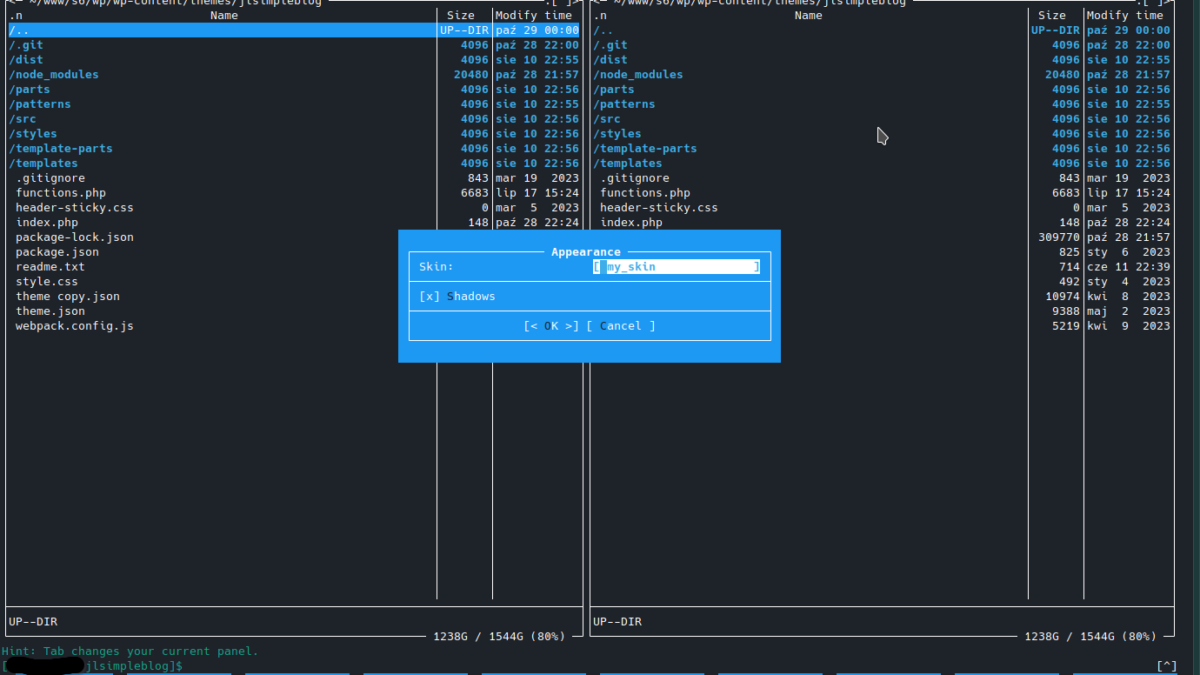
Color customization in Midnight Commander allows you to customize its appearance, which can increase efficiency and comfort of use. This is quite simple and intuitive process that can be handled even by less experienced developers. By modifying the configuration file or using the built-in menu, users can experiment with different color palettes and customizing MC to their own preferences. Regardless of whether you strive to improve readability or simply want to give the tool a more personal touch, with Midnight Commander you can easily set your preferred colors 🙂

